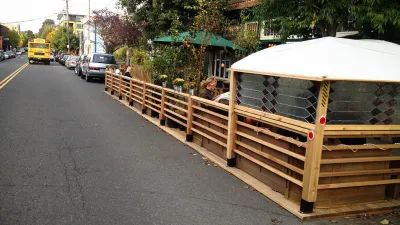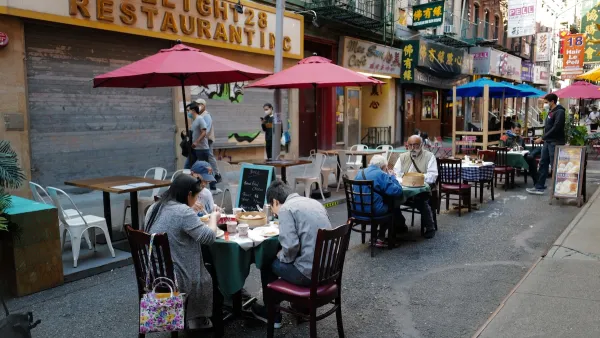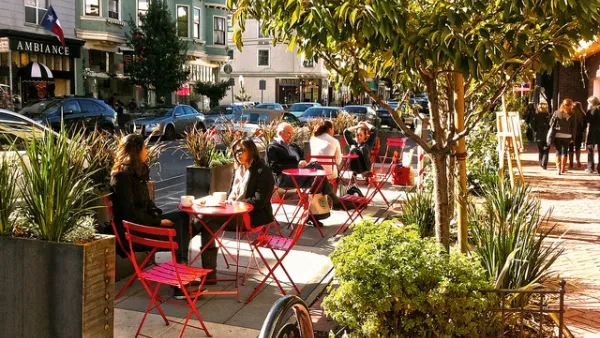Emily Badger of The Washington Post Wonkblog writes about a new study showing the economic benefits of converting street spaces in front of storefronts to parklets. Other options for street spaces include bike lanes, bikeshare docks, and bus lanes.

The piece is similar to the recent CityLab article by Eric Jaffe (posted here) that makes the economic case for converting street parking to bike lanes. Emily Badger's main target, though, is the parklet, a sidewalk extension into the street space that can provide a number of uses. "Most of them included tables, planters and bike racks that created something in between a new public park and an outdoor extension to nearby cafes and sandwich shops," writes Badger.
The study she writes about is the work of the University City District of Philadelphia, "a neighborhood development organization that sent interns out in the spring and summer of 2013 to exhaustively record what happened after a half-dozen of these tiny parks were placed."
The result: a lot more people packed into these spaces than could ever be accommodated by a single car.
Not all of these people were spending money at these nearby businesses (that's a good sign — it means that people recognized they could treat these spaces as public parks and not private outdoor restaurants). But the sales data shared by these businesses suggests that the extra foot traffic — and the outdoor attraction — was a boon for business, even when it came at the expense of a little parking.
The takeaway is that the study provides additional evidence "that a parking spot isn't always the best use of roadside real estate, although we often treat it as such," writes Badger. "And there are some signs that bikeshare docks boost business nearby, too," referencing a study done last year on Capital Bikeshare docking stations and effects on nearby business activity, also posted here.
FULL STORY: Why parking spaces shouldn’t always be wasted on cars

National Parks Layoffs Will Cause Communities to Lose Billions
Thousands of essential park workers were laid off this week, just before the busy spring break season.

Retro-silient?: America’s First “Eco-burb,” The Woodlands Turns 50
A master-planned community north of Houston offers lessons on green infrastructure and resilient design, but falls short of its founder’s lofty affordability and walkability goals.

Delivering for America Plan Will Downgrade Mail Service in at Least 49.5 Percent of Zip Codes
Republican and Democrat lawmakers criticize the plan for its disproportionate negative impact on rural communities.

Test News Post 1
This is a summary

Test News Headline 46
Test for the image on the front page.

Balancing Bombs and Butterflies: How the National Guard Protects a Rare Species
The National Guard at Fort Indiantown Gap uses GIS technology and land management strategies to balance military training with conservation efforts, ensuring the survival of the rare eastern regal fritillary butterfly.
Urban Design for Planners 1: Software Tools
This six-course series explores essential urban design concepts using open source software and equips planners with the tools they need to participate fully in the urban design process.
Planning for Universal Design
Learn the tools for implementing Universal Design in planning regulations.
EMC Planning Group, Inc.
Planetizen
Planetizen
Mpact (formerly Rail~Volution)
Great Falls Development Authority, Inc.
HUDs Office of Policy Development and Research
NYU Wagner Graduate School of Public Service




























